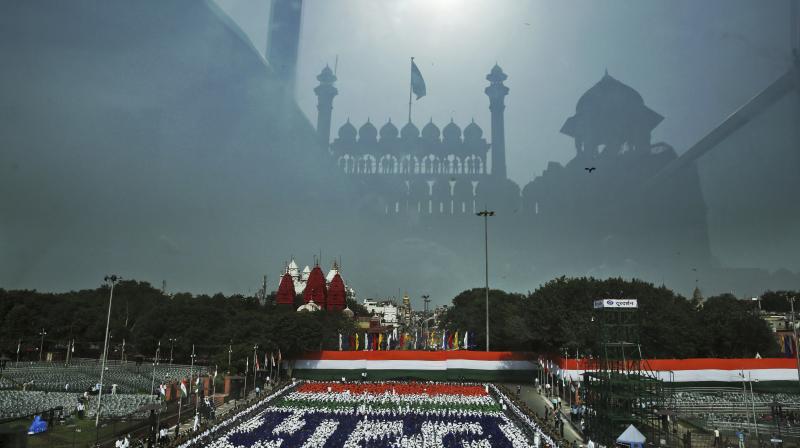As many challenges loom overseas, India needs inclusiveness at home

On the 70th anniversary of India’s independence from colonial rule, multiple foreign policy challenges loom for the republic. The last course correction was a quarter-century ago when the Cold War had ended. India’s close friend, the Soviet Union, ceased to exist as a nation and the Pakistan-Saudi-US combine’s victory in Afghanistan expanded Pakistan’s strategic space and an American-led unipolar world emerged.
The 9/11 attacks on the United States in September 2001, heralding the arrival of radical Islam as Al Qaeda, and China’s ascent as a disruptive force dawned on the US as the 21st century began. A series of Indian Prime Ministers beginning with P.V. Narasimha Rao adjusted Indian foreign policy to a world rapidly changing as global economic and political power was redistributed.
President Donald Trump’s election brought new disruptions via ad-hoc decision-making. Six months in power, he has oscillated between engaging and threatening China, North Korea, Iran and fellow members of Nafta like Mexico and Canada. His Russian gambit with President Vladimir Putin as the linchpin for resolving the West Asian quagmire and containing Iran has come unstuck as the US Congress, in the face of an expanding inquiry into the Russian links of President Trump’s relatives and associates, expanded sanctions on Russia. Even India would have to study them carefully as they include defence sales and energy cooperation.
The challenges in India’s neighborhood seen be viewed against this setting. The principal challenge is of course China, which after decades of clandestine and subtle penetration in South Asia now links its footprint to the Belt and Road Initiative (BRI). From blocking India’s entry into the Nuclear Suppliers Group and the listing of terrorist mastermind Masood Azhar by the UN sanctions committee, it finalised the China-Pakistan Economic Corridor (CPEC), traversing Gilgit-Baltistan, which is claimed by India, and then linked it to BRI. India boycotted the BRI forum in Beijing arguing that the initiative lacked financial viability and ignored sovereignty issues.
The Doklam standoff is India drawing a red line on Chinese conduct along the Line of Actual Control, where China interminably seeks creeping control over contested territory. The logjam can be broken only if China is willing to recognise strategic Indian interests and demonstrates willingness to give and take, say by amending its stand on India’s NSG membership and the listing of known terrorists. Meanwhile, India must be ready for a military response to any Chinese adventurism as China has been emboldened by its successful bullying efforts over the South China Sea. China has also managed to undermine Asean’s unity by propping up countries like Cambodia to curtail China-bashing. China may blink as its economy tries to overcome the loss of its low-cost advantage as other manufacturing hubs rise. Commercial vehicle exports fell from 900,000 in 2014 to 700,000 in 2016. Similarly, while merchandise exports doubled in 2006-11, they have just risen by 11 per cent since then. US President Trump has also announced an inquiry, to decide trade sanctions on China, into Chinese rules that force foreign investors to hand over technology.
The other major conundrum for Indian policymakers is, of course, Pakistan. The Narendra Modi government has tried to break the cycle of dialogue and terror by vetoing any talks until terror ends, accompanied by a security crackdown in Jammu and Kashmir. Common sense and global counter-terrorism experience dictates that a combination of the carrot and the stick works best. Winning over hearts and minds is a condition precedent to getting a grip on domestic terror and choking off further recruitment. The Modi government contrariwise wishes to tire out the population by a hard-fisted approach and frustrate the Pakistan Army by a tit-for-tat response at the Line of Control. A stalemate of sorts persists, the endgame being unclear. Pakistan PM Nawaz Sharif’s ouster and his Rabri Devi-style “solution” of having his wife as his eventual successor, and not his brother Shahbaz, now the chief minister of (Pakistan) Punjab, will prolong the instability. Shahbaz, with his experience and a good equation with the Army, may have been the man of the hour that Pakistan really needs. But all this will have little impact on India-Pakistan relations as the Panama Papers inquiry had already weakened Pakistan’s PM and a belligerent India only increased the Army’s space for manoeuvre on India-Pakistan relations.
The real challenge would be the playing out of Sino-Indian rivalry in Nepal, Sri Lanka and the Maldives as political leaders there use the crutch of China to stymie India. The ceding by Sri Lanka of control over 15,000 acres around Hambantota as Chinese debt settlement is an example of how Chinese influence will penetrate India’s neighborhood. India allowing a dictator to bully his opponents in the Maldives is again poor geostrategic management of a crucial island chain which provides forward maritime defence to India. India has a natural convergence of interests with Russia and Japan. When President Putin announced in 2016 “The Great Eurasian Project”, he aimed to stymie China from filling the vacuum created by US withdrawal from Afghanistan and Central Asia. A mercurial Donald Trump is poor comfort for India’s strategic rebalancing. Europe led by an economically weakened France and a reluctant Germany doesn’t play much of a global pole. An Islamic world fragmented between Shia and Sunni blocs and according to its dependence on Russia or the US presents yet another challenge. The Islamophobia that emanates from the BJP’s fringes will doom any transactional wooing of Gulf and West Asian rulers. The challenge for policymakers is to ensure peace at the borders and to deescalate tensions with China and Pakistan. Resenting every Chinese move in the neighbourhood would only lose India friends unless India has a counter-offer to put on the table. Finally, Indian diplomacy gains when there is inclusiveness and harmony at home. If this is ignored, India may find it difficult to make its tryst with its 21st century destiny.

